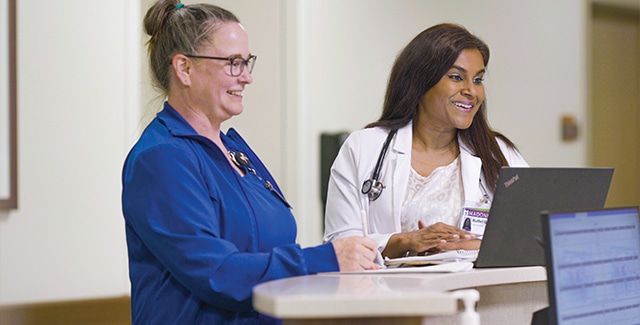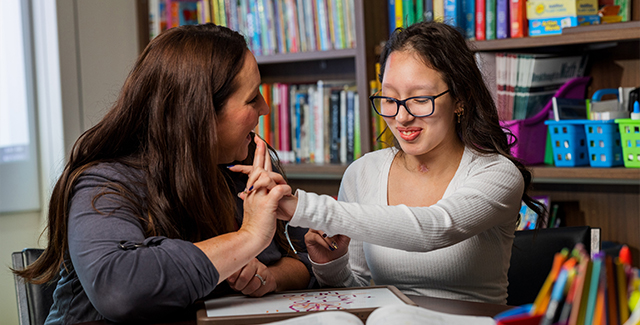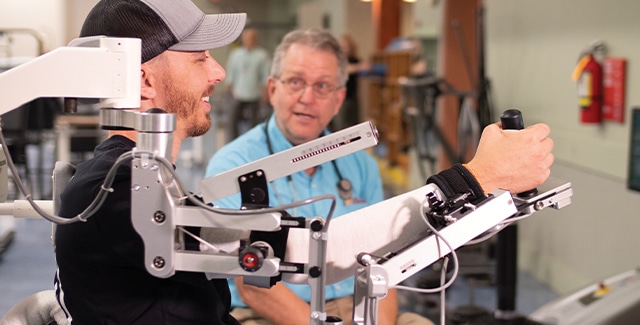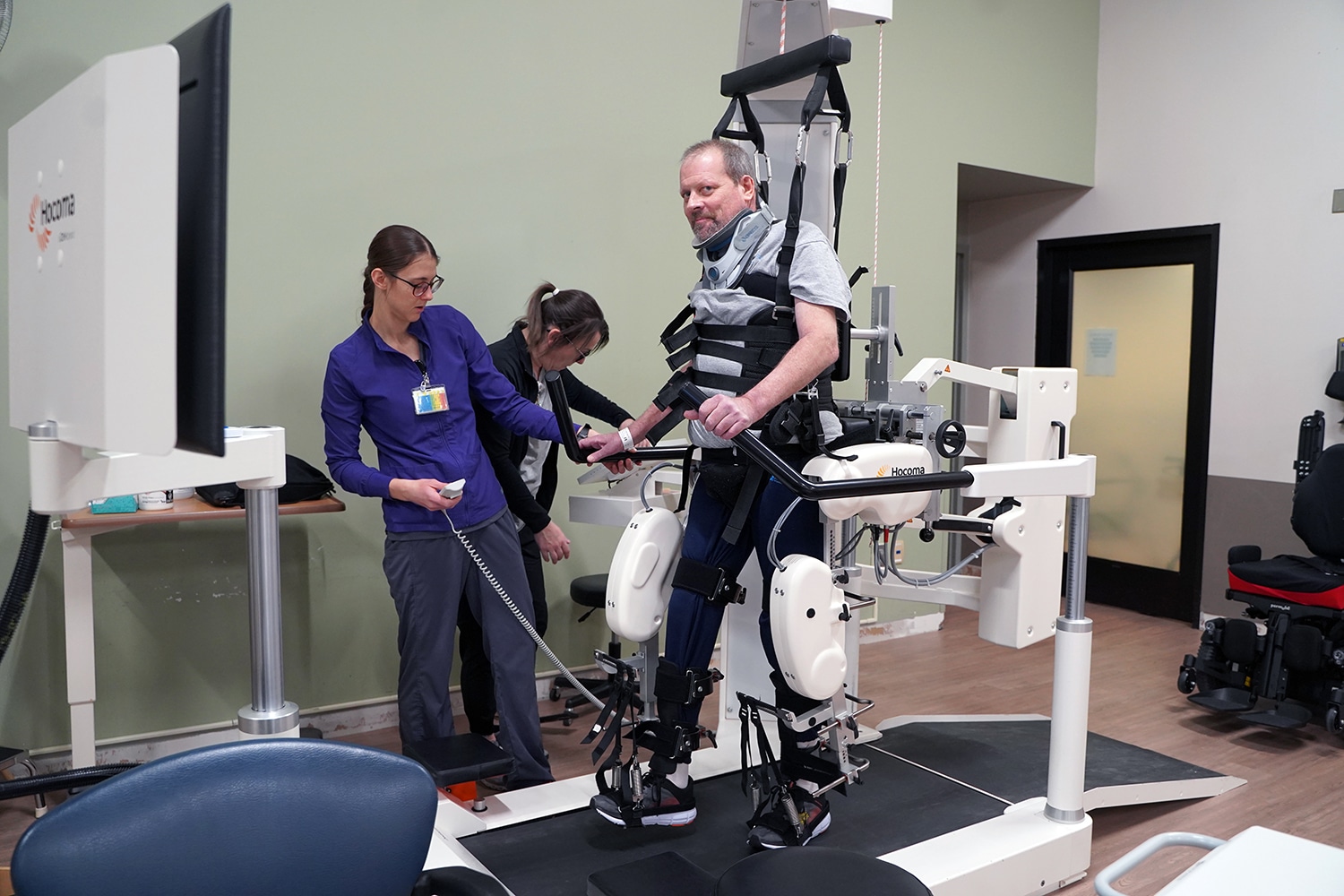Just like his beloved Kansas City Chiefs, Tim Kelsey brings his game face to his therapy sessions at Madonna Rehabilitation Hospitals. The 48-year-old father of four from Odessa, Missouri, has proven he’s not one to shy away from a challenge, as he recovers from an incomplete spinal cord injury he sustained in November 2024.
“I was in a truck accident in October,” he said. “I ended up flipping it and getting thrown 25 feet. I was in the hospital for about five days. My C7 was fractured, but I walked out of the hospital and walked around for two and a half weeks after that.”
Tim thought he was well on his way back to full strength. Then, he started to have pain in his arm and began to lose function in his feet early in November. During an emergency surgery at a Kansas City hospital, doctors found an abscess that had settled into his spinal cord and a staph infection from being in the hospital previously. He had four more surgeries trying to correct the paralysis he was experiencing.
“They told me basically, ‘It’s a 50/50 shot of whether it’s going to work or not,’” Tim said. “Nothing worked. They ended up shaving off a bunch of my spine to make room up there in the cervical area. They told me I wasn’t ever going to move anything again.”
Tim says it was a tough pill to swallow, from walking an estimated 10 to 12 miles a day at work and coming home to be an active dad, to being completely unable to move his body. After a month in the hospital, he came to Madonna’s specialized spinal cord injury program on a private medical plane. He couldn’t sit up on his own and was scared of what his future might look like.
“I lost a lot of muscle mass to where I couldn’t even lift a finger,” Tim said. “When I got here, I couldn’t move anything. Just my mouth. I could move my mouth and I could talk a lot.”
In Madonna’s Specialty Hospital, Tim started small, working on regaining movement in his hands and feet. Doing puzzles with occupational therapy activated his left arm and improved his fine motor skills. He went from using a mouthpiece to navigate his wheelchair to controlling it with his hands. His upper body strength started to build, and after five weeks, he moved to Madonna’s Acute Rehabilitation Hospital, the next step in the organization’s continuum of care. Therapies increased and became more intense.
“It’s a slow journey with spinal cord injury recovery, but he has improved his strength,” Laura Selivanoff, PT, DPT, Tim’s physical therapist, said. “Things like taking steps, it’s tough for him to do, but it’s really exciting to see him being able to try and initiate that.”
Selivanoff used specialized technology like the Lokomat robotic gait trainer to increase Tim’s standing tolerance and mobility. She then upped the challenge by removing the robotic legs and having Tim move his legs on his own.
“We know that getting a lot of mass repetition of movement is the most important thing when it comes to neurological rehab, so the fact that Tim shows up every day, he’s willing to give it his best effort, keeps his sense of humor and a smile, that really helps go a long way,” Selivanoff said.
Tim’s occupational therapist, Dani Willey, OTR/L, DRP, said that as he became more independent, his jokester personality emerged.
“You could tell he was proud of himself, and we were proud of him,” Willey said. “Just being able to do more as far as feeding yourself and brushing your own teeth, being able to get something off the counter that you need–those were big goals. They may seem like little things, but that’s what I think made him feel a little more back to himself.”
Willey recalls one session where she was helping Tim use the functional electrical stimulation (FES) bike on his arms when they got on the topic of conspiracy theories.
“He and I had the funniest conversations about, ‘Oh, what’s going to happen when the aliens invade?’” Willey said. “Then we started telling other people, like, ‘You guys better be prepared. Everybody better have a plan!’ We laughed about that for days!”
Staff say Tim was always quick with a joke or a witty comment. He was always telling people how he planned to write a book about his experience, and that the marketing department was making a documentary about him. But when it came time to work hard, he was all business.
“I know that was a big thing for him, saying ‘I want to be more independent. I don’t want to be a burden on my family. I want to be able to do as much as I can on my own,’” Willey said. “He’s still got a long road to recovery, but we definitely started him off on the first step for that.”
In two months in Madonna’s Acute Rehabilitation Hospital, Tim saw improvements in his grasp and coordination. He could brush his teeth and feed himself, and used a dressing stick to put his shirt on by himself. He also used Madonna’s warm-water therapy pool to practice taking unassisted steps.
“I was stumbling quite a bit, but still, being able to walk was good and get that feeling again of standing straight up and look somebody straight in the eye talking with them,” Tim said.
Looking back and when doctors told him they weren’t sure he’d ever move any parts of his body again, Tim says he’s never given up hope. There have been challenging days, but he keeps grinding.
“If you’re negative, you’re going to get negative results,” he said. “This is the hand I’m dealt. Whether it’s positive or not, you can still be positive and push forward.”
As he moves on to the next step in his recovery journey, Tim says he has one ultimate goal when he returns home.
“I hope to keep seeing progress in my legs, and hopefully I’ll be able to walk in there to that surgeon who told me I’d never move again, and ask for my money back,” Tim jokes. “That’s what my plan is. That’s one thing I’ll be looking forward to.”





